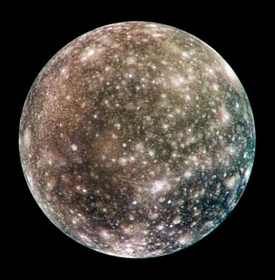JUICE's secondary target: Callisto
 |
| Callisto. Credit: NASA/JPL/DLR |
Despite these similarities, in many ways this Galilean moon is very different from its icy companions. Because of its remote location, orbiting beyond Jupiter's main radiation belts, Callisto sees lower radiation levels and less influence from the Jovian magnetosphere than Ganymede and Europa. The 1 880 000 kilometre distance from Jupiter, and the fact that Callisto is relatively isolated from the other Galilean satellites, also means that tidal heating at the moon is not significant, making it far more geologically stable than the inner Galilean moons.
A fossil from the formation era
Callisto has an old, heavily marked landscape, with impact features covering the moon's entire surface and with landforms showing signs of intense erosion. In fact, Callisto's surface is the oldest and most densely cratered of any body in the Solar System. The lack of resurfacing or other signs of geologic activity on the moon's surface point to Callisto being a long-dead world, a remnant of the early Jovian system. As such, it can provide scientists with a unique window to explore the early stages of formation of the Galilean moons.
 |
| Landslides on Callisto. Credit: NASA/JPL/ASU |
JUICE will investigate Callisto's cratered surface in detail to find out more about the moon's past activity. The mission's observations will allow us to constrain the moon's surface ages, both at the global and local scales, and to study erosion and asteroid-dust deposition processes on Callisto's landforms. Scientists hope to find out how much of a role tectonics and other geologic processes played in moulding the moon's surface in the past, and how much influence impact activity has had in Callisto's evolution.
At the surface, JUICE will study the composition and chemistry of Callisto's rocky and icy materials. Researchers aim to identify the various organic and non-organic compounds that make up the moon's surface, relate them to the moon's geology, and understand how high-energy particles from the Jovian space environment can alter Callisto's surface composition, a process called space weathering.
Disentangling a differentiated interior
The mission will also study the moon's subsurface and interior. Callisto is thought to have some differentiated layers in its interior: a small rocky inner core surrounded by a mantle mostly made up of ice. In addition, the Galileo spacecraft found evidence for a possible subsurface ocean. That mission detected an induced magnetic field at Callisto with characteristics that suggest the moon could have an underground layer of liquid salty water.
By investigating the moon's gravity field and shape, JUICE's instruments will be able to probe Callisto's interior structure, including its degree of differentiation. If a subsurface ocean does exist, JUICE will study its properties, and constrain the thickness of the icy crust above it. In addition, JUICE's ice-penetrating radar will map the moon's subsurface down to a few kilometres to investigate the icy shell.
Between surface and space
Galileo's measurements of an induced magnetic field at Callisto could also be explained, in part, by an ionosphere capable of conducting electric current. A key goal for JUICE is to find out the role the ionosphere plays in producing the measured field, to separate this contribution from that of the interior liquid layer and to better constrain the ocean's properties.
Finally, JUICE will investigate Callisto's thin atmosphere, which is mostly composed of carbon dioxide. Because it is so rarefied, the atmosphere would escape to space in a few days; as such, there has to be a process at Callisto that continually replenishes carbon dioxide. A possibility is that carbon-dioxide ice at the moon's surface slowly sublimates away into the atmosphere. JUICE will help to uncover this mystery.
JUICE will fly past Callisto 12 times, at altitudes between 400 km and 200 km at closest approach.
